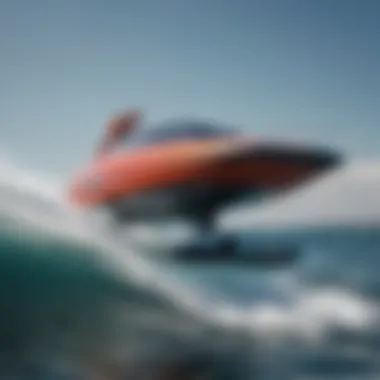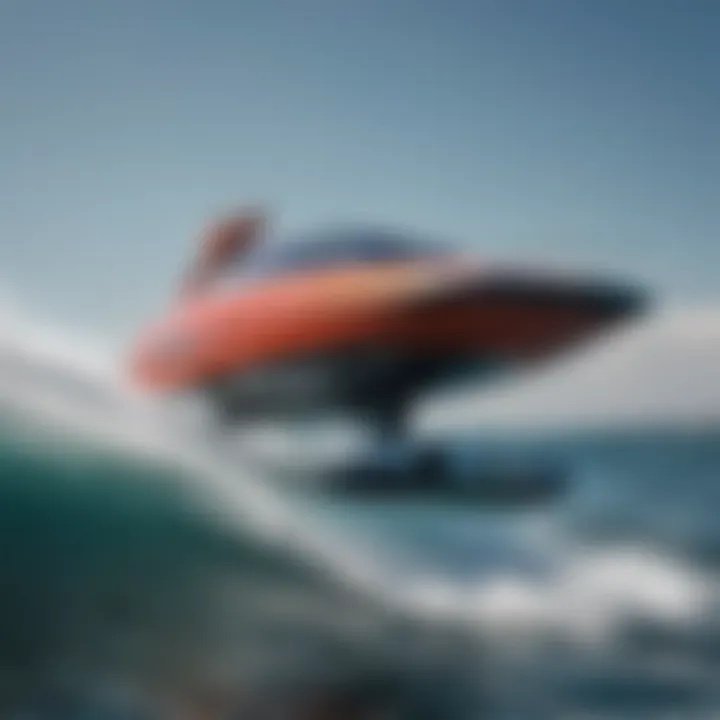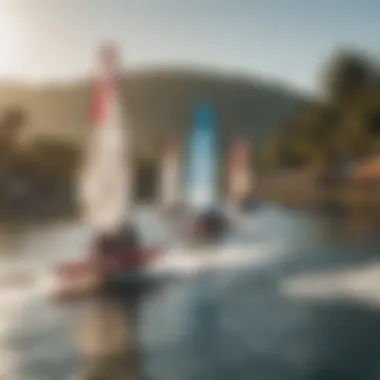The Evolution and Impact of One-Person Hydrofoiling


Intro
One-person hydrofoiling marks a thrilling intersection of innovation, sport, and adventure. Over the past decades, these unique vessels have captured the imagination of watersport enthusiasts, turning ordinary days on the water into exhilarating experiences. Picture this: you're gliding over the water, elevated by a sleek hydrofoil, feeling the rush of wind and water in perfect harmony. It’s not just about the thrill; it's about the evolution of a sport that continues to redefine what’s possible on water.
This guide aims to untangle the myriad layers of one-person hydrofoiling, tracing its roots from early experiments in hydrofoil technology to the sophisticated gear that defines today's scene. From there, we’ll highlight how this sport has transformed not only the experience of participants, but also its impact on the coastal communities and environmental awareness. Whether you’re just gearing up to try your first ride or you're an experienced athlete aiming to perfect your technique, this narrative is designed to engage, inform, and inspire.
As we venture deeper into the world of hydrofoiling, keep in mind its captivating blend of art and science, where every droplet of water contributes to the story. With that said, gear up, and let's dive into the essentials that make hydrofoiling a unique sport.
Foreword to One-Person Hydrofoiling
In recent years, one-person hydrofoiling has emerged as an exhilarating and innovative water sport, captivating adventurists and sports lovers alike. This unique activity involves a single rider balancing on a board equipped with hydrofoils, allowing for a radically different experience on the water compared to traditional surfing or paddleboarding. The sensation of gliding above the surface, almost flying, presents not only a thrilling challenge but also a novel method of riding the waves.
Understanding the importance of one-person hydrofoiling lies in its transformative impact on the culture of water sports. It combines elements of existing pursuits, such as surfing, kitesurfing, and stand-up paddleboarding, while introducing unique mechanics and techniques that draw enthusiasts of various backgrounds. Hydrofoiling highlights advancements in technology and design, making it accessible to a broader audience. Moreover, its adaptability lends itself to different water conditions, presenting fresh opportunities for exploration and enjoyment.
Understanding Hydrofoils
Hydrofoils are structures that lift a craft above the water’s surface, reducing drag and allowing for smoother rides. They are comprised of underwater wings that provide lift when a specific speed is reached. For one-person hydrofoiling, it's particularly remarkable how these designs have evolved, allowing for greater stability and control. Riders, particularly newcomers to the sport, find it essential to grasp how these mechanics work, as they significantly influence overall performance.
One noteworthy example is how the design of the foil wings impacts the ride. Different shapes cater to varying speeds and riding styles, offering customization that enhances the user experience. Riders can choose wings designed for swift maneuvers or those focused on stability and control, depending on their riding preferences.
Historical Background
The origins of hydrofoiling date back to the early 1900s, with various inventors experimenting with the concept. However, it wasn’t until the late 20th century that serious developments occurred in hydrofoil technology, significantly elevating its practical applications for water sports. Initially used in boat designs, hydrofoils transitioned to smaller watercraft, paving the way for the advent of one-person hydrofoils.
By the early 2000s, enthusiasts began to adapt existing surfboards into hydrofoil boards, creating a niche market that began to thrive. The rise in interest coincided with advancements in materials like carbon fiber, which notably improved the strength-to-weight ratio of boards. This shift meant that aspiring hydrofoilers could invest in lightweight equipment, enhancing both performance and agility.
Today, one-person hydrofoiling stands as more than just a fad; it signifies a substantial evolution within the water sports domain. It offers unique experiences while fostering community among those who seek to push the limits and explore the maritime world in a new light. Individual riders now have access to various platforms and resources, creating a vibrant culture that continues to evolve.
"One-person hydrofoiling takes water sports to an entirely new level, where the thrill of flight meets the tranquility of the ocean."
As we delve deeper into the intricacies of hydrofoiling, we will explore the mechanics at work and factors influencing performance, providing a comprehensive understanding of why this sport is gaining traction among enthusiasts globally.
Mechanics of Hydrofoiling
The mechanics governing hydrofoiling are integral to understanding how these innovative craft operate. As the sport continues to attract enthusiasts from all walks of life, grasping the basic mechanics not only enhances performance but also elevates the overall experience on the water. Hydrofoiling offers an exhilarating way to glide above the water’s surface, combining physics with a sense of freedom. The interplay between lift, drag, and design intricacies determines how effectively a hydrofoil performs, making the following concepts crucial to practitioners.
How Hydrofoils Work
Lift and Drag
Lift and drag are two primary forces at play when a hydrofoil is in motion. Lift is generated by the foil’s shape and angle of attack, while drag is the resistance the hydrofoil experiences as it moves through the water. A well-tuned hydrofoil achieves an optimal balance between these forces.
A key characteristic of lift is that it can allow a rider to "fly" just above the water. This buoyancy is what makes hydrofoiling so popular among watersport enthusiasts. The unique feature here is the ability to reduce drag significantly at higher speeds, giving riders an almost magical experience of gliding across the surface. However, it’s worth noting that achieving this balance requires a fair bit of skill and specific equipment. Misjudgment can lead to loss of stability, causing abrupt descents into the water.
Foil Design Principles
The principles surrounding foil design are often as nuanced as they are essential. A fundamental aspect involves understanding the hydrodynamic profiles that allow foils to perform effectively. Designs can vary significantly—from short, wide foils for better stability to long, narrow variants that cut through the water more efficiently.
One notable characteristic of modern foil designs is the focus on versatility and performance. Riders often have a choice between fixed wings and adjustable designs. The unique feature here is the adaptiveness to various conditions. For instance, those aiming for smooth, calm waters could opt for a different design than those tackling chop. Each design houses its own advantages and limitations, often requiring the rider to consider the environment before making a choice.
Performance Factors
Weight Distribution
Weight distribution is another pivotal factor in hydrofoiling. To optimize lift, the rider’s weight needs to be strategically placed. Leaning back can lift the front, reducing drag, while positioning the body forward can control the descent. It’s crucial to note that weight distribution not only affects stability but also offers a means to adapt to changing conditions on the water.
The critical benefit here is an enhanced control over the hydrofoil’s response. A laid-back weight distribution allows for smoother transitions when maneuvering turns, while a more aggressive stance might be favorable at higher speeds. The challenge, however, is that incorrect weight shifts can lead to unintended nose dives, ending in a rather abrupt immersion.
Speed Dynamics
Speed dynamics play a vital role in how a hydrofoil operates. As one speeds up, lift increases, which allows for that quintessential flying expression associated with hydrofoiling. At higher speeds, the hydrofoil can soar above waves and choppy waters, creating an exhilarating sensation.
Here’s an interesting aspect: the relationship between speed and efficiency often requires riders to maintain a consistent pace to optimize lift and minimize drag. Riders who can find this sweet spot often report a unique feeling of gliding through the air. However, speed tricks can backfire if not handled with finesse—too much speed can compromise control, leading to instability.
Understanding the mechanics of hydrofoiling is essential, as it forms the backbone of both performance and safety. The complexity of lift, drag, weight distribution, and speed dynamics paints a detailed picture of this enthralling sport, allowing enthusiasts to sharpen their skills and enjoy their time on the water.
Types of One-Person Hydrofoils
Diving into the various types of one-person hydrofoils reveals not just options, but a broad array of benefits and considerations that appeal to both novices and seasoned riders alike. Each type of hydrofoil strikes at a different chord—whether it’s the thrill of the ride, performance needs or even environmental impact. Understanding these different choices can aid enthusiasts in deciding what fits their style and requirements the best.
Foil Board Options
Construction Materials
When it comes to the construction materials of hydrofoils, the focus often falls on weight, durability, and performance. Most modern hydrofoils manufacturers have extensively experimented with various materials, but the standout is undoubtedly carbon fiber. This material is renowned for being lightweight while maintaining a strong and rigid structure, making it a favored choice for many athletes.
A key characteristic of carbon fiber is its high strength-to-weight ratio, which translates to better performance on the water. Hydrofoils made from carbon fiber offer better lift and stability, allowing riders to up their game and ride longer with less fatigue. However, the one hitch? The cost. Carbon fiber foils tend to be pricier than those made from other materials like aluminum or plastic, which can be a turn-off for budget-conscious beginners.
An additional point worth noting about aluminum options is that, while they generally come at a lower price point and provide decent strength, they can be heavier and less responsive. That could impact the riding experience. So, if one is looking for performance without breaking the bank, aluminum could serve as an adequate introduction, but carbon fiber typically remains the gold standard.
Shape Variations
The shape of the hydrofoil board can dramatically influence how it handles the water. Variations in shape can determine stability, control, and speed, making this an essential consideration when selecting a hydrofoil.


A common shape among experienced riders is the thinner, elongated profile, which supports high-speed runs. This shape can cut through the water efficiently, enhancing speed and performance. On the other hand, wider and more rounded boards can offer a bit more stability, making them a solid option for beginners still finding their footing.
Each shape contains its own unique features. For instance, a longer board can tend to maintain speed better, ideal for those seeking to push their limits on flat waters. However, the trade-off is that they may be tougher to maneuver in tight spots or turbulent conditions, possibly frustrating newer riders.
In contrast, shorter boards can provide better maneuverability but may sacrifice some top-end speeds. Hence, being clear about one’s riding intentions and conditions is crucial when choosing the appropriate shape.
Wing Configurations
High Aspect vs. Low Aspect
Wings are another significant aspect of hydrofoiling that merits closer inspection. Broadly categorized, we can talk about high aspect and low aspect wings, each providing distinct advantages depending on rider preference and intended use.
High aspect wings typically feature a longer and narrower profile. This shape is favored for its efficiency and lift capabilities, making it suitable for high-speed experiences and open-water rides. Riders down that path often enjoy faster speeds and more responsiveness during turns. However, mastering these wings can come with a learning curve, especially for beginners.
Low aspect wings, in contrast, are shorter and wider, providing increased stability and maneuverability. They are particularly advantageous for those still getting their sea legs on the water. However, the trade-off is that they may not lift as effectively at higher speeds, resulting in a different riding feel.
Custom Wings
Finally, custom wings have been gaining traction among one-person hydrofoilers and it’s easy to see why. They allow for highly personalized adjustments based on rider preferences or particular conditions. You want something more responsive in choppy waters? No problem; it can be tailored to mitigate that.
The critical feature of custom wings lies in their adaptability to varied riding styles, weights, and skill levels. This capability makes them an enticing option for those seeking an edge or an improvement in their performance. Of course, custom wings often demand a higher investment, so weighing the benefits against the cost is always prudent, especially for riders just testing the waters.
"The right wing can transform your ride; it’s not just about good equipment, but the right equipment for you."
The types and configurations of one-person hydrofoils add an intricate layer to the sport, enriching the overall experience while allowing for personal expression on water.
Understanding these variations is essential for informed choices, ultimately allowing enthusiasts to find what resonates most—blending thrill, efficiency, and fun.
The Growing Popularity of Hydrofoiling
Hydrofoiling has shifted from a niche activity to a mainstream watersport in recent years. The forces at play behind this surge in popularity intertwine technology, accessibility, and a community spirit fostering shared experiences. Observing its trajectory, we can glean insights into why this seemingly novel means of gliding over water has captured the interest of so many.
Demographics of Hydrofoil Enthusiasts
Age Groups
When looking at who is diving into hydrofoiling, it's quite fascinating to see a broad spectrum of age interacting with this sport. Younger enthusiasts, often in their late teens to early thirties, single out hydrofoiling as an exhilarating challenge. This group, drawn by the adrenaline rush and the search for adventure, thrives on trying new tactics and tricks. It’s more than just a past-time; it’s a pursuit where conquering the learning curve feels like a mini victory.
On the other end of the age spectrum, middle-aged riders find the thrill of hydrofoiling just as enticing. They approach the sport seeking balance—both physically and mentally—finding joy in the simplicity of gliding above the waves. This demographic often appreciates the lower impact nature of the sport compared with traditional methods, which can be taxing on the body. However, the challenge presented by hydrofoils can sometimes appear daunting, leading to a slower adoption rate among the older crowd.
In summary, hydrofoiling attracts varying age groups, creating a unique blend of skill and ambition across generations.
Geographic Trends
Geography plays a significant role in the spreading popularity of hydrofoiling. Coastal regions with access to open waters, like California or Florida, serve as hotspots for enthusiasts. These locations benefit from favorable wind conditions and open-water access, making hydrofoiling an appealing option.
Interestingly, inland lakes are also seeing a rise in popularity. Enthusiasts are adapting hydrofoiling to quieter waters, showcasing its versatility. However, this regional appeal presents some mixed blessings. On one hand, it allows more people access to hydrofoiling, creating new communities. Yet, on the other, increased local interest might lead to congestion, making it a less appealing experience for some.
The distinct geographic variations highlight how hydrofoiling can adapt to various landsapes and communities, driving interest while also needing to manage growth.
Hydrofoiling in Competitive Sports
Racing Events
As hydrofoiling grows, so too does its representation in competitive realms. Racing events serve as a cornerstone for spreading awareness and excitement surrounding the sport. These competitions not only attract seasoned riders but also encourage newcomers to jump in the fray. Racing brings with it an electrifying atmosphere, where speed and skill showcase the very best of what hydrofoiling has to offer.
Events such as the Hydrofoil World Championships are pivotal in cultivating talent and igniting interest. They highlight a key characteristic of hydrofoiling: its competitive spirit. That thrill of competition can be incredibly motivating for both participants and spectators alike. However, the competitive nature does sometimes intimidate potential newbies, presenting a barrier to entry for those just starting their journey.
Showcasing Skill
Beyond racing, hydrofoiling serves as a canvas for skill demonstration. Rides showcasing complex tricks elevate the sport's profile, drawing in an audience from various watersport communities. These skill showcases not only demonstrate personal athleticism but also inspire others to join the movement.
The unique aspect of showcasing skill lies in its ability to attract attention and build community. You might find video clips of intricate maneuvers circulating on social media, creating a buzz that pulls onlookers into hydrofoiling's embrace. The drawback? Newer riders might feel overwhelmed by the high skill level demonstrated by veterans, potentially stalling their enthusiasm.
Overall, the intertwining of racing and skill showcases propels hydrofoiling further into the spotlight, fostering a culture built on community and personal achievement.
Safety Considerations
The topic of safety considerations in hydrofoiling can't be taken lightly. It combines thrill with potential hazards, and that’s like mixing fireworks with a rainstorm. Enthusiasts should always prioritize safety as they embark on their water adventures. The rich experience of riding a hydrofoil comes with numerous elements that demand attention to ensure an enjoyable and secure outing on the water.
Essential Safety Gear
Impact Vests
When it comes to safety gear, impact vests are like an insurance policy for hydrofoilers. They're designed to absorb sudden impacts, which can be a lifesaver, especially during wipeouts. The key characteristic of impact vests is their buoyancy and protective padding, offering a blend of comfort and security. They are particularly beneficial for those who may be just starting or those who tend to challenge themselves with tricks and stunts.
A unique feature of these vests is the incorporation of advanced materials that provide both flexibility and durability. Many modern versions are lightweight, allowing for easy movement while remaining robust. However, while they provide protection, they don’t guarantee complete immunity from injury. It's important to note they should be worn as an addition to other safety measures, not as a substitute.
Wetsuits
Another essential piece of gear is the wetsuit. They offer thermal insulation, helping to keep the body warm in chilly waters. This characteristic makes wetsuits a popular choice among hydrofoilers who often venture out in less than ideal weather conditions. They contribute significantly towards overall comfort during long sessions on the water, which can be especially valuable for those needing to stay in for extended periods.
Wetsuits come in various thicknesses, making it easier to select one that fits your local climate. A unique feature of this gear is its flexibility; many now incorporate stretchable materials that allow maximum mobility, an important aspect of hydrofoiling. However, they can be a bit tricky to put on, which might be a disadvantage for some newcomers. Nevertheless, dealing with that minor inconvenience is a small price to pay for the benefits they offer.


Common Risks and Mitigation
Potential Injuries
Every sport comes with its set of risks, and hydrofoiling is no exception. Potential injuries can range from minor scrapes and bruises to more serious issues like concussions or lacerations. It’s crucial to understand how these injuries can occur, as it strengthens the motivational drive to use protective equipment and adopt safer practices. A significant characteristic of potential injuries in hydrofoiling is their relation to speed and maneuverability, where a moment of carelessness can lead to a nasty fall.
Education and awareness are essential. By recognizing what injuries are common, hydrofoiling enthusiasts can take preemptive measures to avoid them. However, accidents do happen, and injuries can still occur despite best efforts, making it essential to have a plan for dealing with mishaps on the water.
Best Practices
Implementing best practices is an effective way to mitigate the risks associated with hydrofoiling. Best practices involve a mix of thorough training, using appropriate gear, and staying informed about the conditions of the water and weather. Key among these practices is always riding within one's skill level and ensuring that the equipment used is not only appropriate but also in good condition.
Unique to best practices is the habit of undergoing regular assessments of one's skills and knowledge about the sport. Familiarizing oneself with safety protocols, such as how to handle equipment and what to do in emergencies, elevates the overall safety profile significantly. While strict adherence to practices can feel limiting at times, it ultimately leads to a more enjoyable and secure hydrofoiling experience.
Environmental Impact of Hydrofoiling
The increasing interest in one-person hydrofoiling brings with it questions about its environmental impact. It’s crucial to understand the relationship between this thrilling sport and the ecosystems it interacts with. Through responsible practices and innovative developments, hydrofoiling can be an environmentally conscious choice for water enthusiasts. By skimming above the waves, hydrofoilers often find themselves more attuned to their environment, potentially fostering an appreciation for marine conservation.
Sustainability Initiatives
Eco-Friendly Materials
Eco-friendly materials play a significant role in the evolution of one-person hydrofoils. Many manufacturers are now exploring options like recycled plastics or bio-resins as alternatives to traditional materials. These materials not only reduce waste but also lessen the carbon footprint associated with production. A key characteristic of eco-friendly materials is their regenerative nature; they often minimize dependence on non-renewable resources, which is a growing concern in today’s world.
Using materials like these can be both beneficial and popular among environmentally conscious consumers. However, it’s important to note that while these materials may have lower impacts, they sometimes come with higher costs, potentially affecting affordability for some users. Balancing environmental good and financial feasibility remains a challenge.
Conservation Efforts
Conservation efforts associated with hydrofoiling are aimed at protecting marine environments that are often threatened by recreational water activities. Programs aimed at clean-up initiatives or habitat restoration can be tied to the hydrofoiling community, fostering a sense of responsibility among its enthusiasts. A standout feature of conservation efforts is their community-driven nature; they often encourage participation from local hydrofoilers, thereby creating bonds.
Such initiatives not only enhance the safety and enjoyment of hydrofoiling but also provide tangible benefits to marine ecosystems. Nonetheless, some conservation programs may struggle with engagement, requiring ongoing efforts to connect with a diverse audience. Ensuring that these initiatives reach a broad spectrum of hydrofoilers is essential for meaningful change.
Hydrofoiling and Marine Life
Minimizing Disturbance
One notable aspect of minimizing disturbance is the design of hydrofoils that minimize wake and sound, crucial for protecting sensitive marine life. Manufacturers are becoming increasingly aware of the noise levels created by hydrofoiling activities, which can interfere with aquatic habitats. Reducing wake not only helps in preventing erosion but also minimizes disruption for wildlife in close proximity.
Many hydrofoiling enthusiasts embrace this concept, tending to choose manufacturing brands that prioritize silent operation. However, while these technologies are becoming more accessible, not all hydrofoils come equipped with these thoughtful features, sometimes leading to overlooked environmental concerns.
Respecting Ecosystems
Respecting ecosystems involves understanding the delicate balance that comes with frequenting marine environments. Hydrofoilers are encouraged to be part of an ongoing dialogue regarding ocean health, which can lead to better practices and a commitment towards preserving these natural resources. A pivotal aspect of respecting ecosystems is recognizing the importance of designated zones for hydrofoiling. Following regulations will not only protect habitats but also ensure sustainable boating practices. While many hydrofoilers do take these considerations seriously, in practice, adherence to guidelines can vary. Some may overlook established rules, risking more harm than good. Constant education and awareness will be key in creating a culture of respect within the hydrofoiling community.
"Every wave we ride is a chance to show our commitment to nature's playground. Understanding our impact is the first step towards responsible enjoyment of hydrofoiling."
Ensuring balance between thrill-seeking and environmental stewardship is paramount. It’s an ongoing conversation that should involve everyone, from manufacturers to enthusiasts, to preserve the beautiful waters we all enjoy.
Technological Innovations Enhancing Hydrofoiling
Technological advancements have become the backbone of the evolution of one-person hydrofoiling. These innovations not only impact the performance and durability of the craft but also drastically influence user experience. As hydrofoiling gains traction among watersport enthusiasts, the integration of advanced materials and electronics remains at the core of enhancing this thrilling sport.
Advancements in Materials
Carbon Fiber
Carbon fiber is a game-changer in the world of hydrofoiling. Its lightweight properties combined with exceptional strength have made it a prime choice for crafting hydrofoils. This material shines particularly because it offers a high strength-to-weight ratio, which is crucial for maintaining stability and control on the water.
One notable feature of carbon fiber is its resistance to corrosion. This is especially beneficial for hydrofoil users who frequently interact with saltwater, as it helps in prolonging the longevity of the equipment. However, one should be mindful that while carbon fiber is powerful, it can be more expensive than traditional materials. Therefore, it appeals more to those serious about their hydrofoiling pursuits, rather than casual users.
"The performance benefits of carbon fiber, while notable, often come at a cost. Enthusiasts must weigh longevity against investment."
Lightweight Composites
When it comes to lightweight composites, we're looking at a mix of materials designed for enhanced performance without the hefty weight. These materials, which often include a blend of synthetic fibers and resin systems, have become increasingly popular for their balance between affordability and performance.
Lightweight composites are often touted for their flexible nature, allowing for more versatility in design and application. A significant advantage is that they allow manufacturers to create custom foil shapes that can cater to specific riding styles or water conditions. But they do come with drawbacks; for instance, they may not offer the same level of strength as carbon fiber, which can result in a shorter lifespan in harsher conditions.
Integration of Electronics
Electric Foils
Electric foils represent a dynamic shift in hydrofoiling. By integrating small electric motors, these foils provide an alternative to traditional paddling or being towed, enabling a smooth and effortless ride. The thrill of gliding over the water without the need for waves or wind truly opens up a new realm for hydrofoiling enthusiasts.
One of the standout characteristics of electric foils is their ability to control speed seamlessly. Users can maintain a consistent speed regardless of water conditions, which enhances the overall experience. The major downside, however, is the need for a charging infrastructure, as well as the added weight of the battery system. For someone who's committed to hydrofoiling, this might not be a deal-breaker, but it is certainly something to consider.
Wireless Connectivity
In today's tech-savvy world, wireless connectivity has found its way into hydrofoiling, making the ride more interactive and engaging. By utilizing apps that communicate with the hydrofoil through Bluetooth technology, users can adjust their setups or monitor their performance metrics in real time.
The primary advantage of wireless connectivity lies in its convenience. Users can track speed, battery life, and even GPS performance directly from their smartphones. However, one must be cautious of over-reliance on technology; performance should still be evaluated based on fundamental skills and adaptability rather than being solely dependent on gadgets. Moreover, connectivity issues could arise, which might hamper the riding experience.
In summary, the incorporation of advanced materials and electronic integration paints a promising picture for one-person hydrofoiling. As innovation continues to push boundaries, the sport's appeal is likely to grow, paving the way for more enthusiasts to take to the waters with a renewed sense of thrill.
Getting Started with Hydrofoiling
Diving into the world of one-person hydrofoiling is not just about hopping on a board and gliding over the waves. It's about understanding the nuances that make this sport a thrilling experience while ensuring safety and style. Whether you are a seasoned watersport enthusiast or stepping onto the water for the first time, knowing how to start right will set the stage for all your future adventures. This section covers the key aspects of getting started, from choosing the right equipment to finding learning resources.
Choosing the Right Equipment
Initial Setup


The Initial Setup of your hydrofoiling gear is crucial, as it serves as the foundation for your entire hydrofoiling experience. Getting this right isn't just about having the right equipment; it's about feeling comfortable and confident in your ride. A well-chosen setup can dramatically enhance your performance, making it easier to balance and control your movements.
A standout characteristic of a good initial setup is the customization possibilities. The foils can be adjusted for different skill levels, weights, and water conditions, meaning every rider can find their sweet spot. This flexibility is extremely beneficial, particularly for beginners who might find the learning curve steeper. The unique feature here lies in the adjustability of board width, foil height, and wing size, allowing for a tailored experience.
However, it does come with its disadvantages. Finding the right balance can feel overwhelming, and the initial costs may add up if you want high-quality gear. Ultimately, taking the time to understand your needs and preferences can make your hydrofoil experience far more enjoyable.
Financing Options
When you step into hydrofoiling, one aspect that can weigh on your mind is the financial investment required. Financing Options available today have made this incredible sport more accessible to many. Many brands, like Naish and Slingshot, offer purchase plans that allow you to spread your costs over months or even years, making it less daunting of a commitment.
One key aspect of these financing options is the flexible payment plans; they can fit almost any budget. This makes it a popular choice for those just discovering the sport or for instructors looking to upgrade their equipment without breaking the bank. The unique feature of such arrangements is that they often come bundled with promotional deals, such as discounts for early payments or bundle offers that include accessories.
That said, keep in mind that financing can become a slippery slope if not managed wisely. Missing payments can lead to increased costs and potential hiccups in your journey. So, weighing the pros and cons, go in with a clear plan.
Learning Resources
Online Tutorials
Another excellent way to get started is through Online Tutorials. The internet is bursting with free and paid resources for aspiring hydrofoilers. Platforms like YouTube have comprehensive guides that cover everything from the basics to advanced techniques, making it easier to learn at your own pace.
One of the key characteristics of online tutorials is their accessibility. You can learn anytime, anywhere, which is a boon for those with busy schedules. Furthermore, you can rewind and replay sections to grasp the finer points of the techniques being taught.
Unique to this aspect is the capacity for community interactions. Many creators invite viewers to comment, ask questions, and even share their progress, forming an engaged community of learners. However, one downside is that the sheer volume of content can be overwhelming, making it tough to determine which tutorials align with your learning style.
Local Classes
For those who thrive in a more structured environment, Local Classes present an outstanding option for navigating the fundamentals of hydrofoiling. You get face-to-face interaction with qualified instructors, who can provide immediate feedback and guidance tailored to your specific needs.
One standout characteristic of local classes is their hands-on training. Practicing under the watchful eye of an experienced instructor not only enhances skill acquisition but also boosts safety, as mistakes can be caught before they turn into accidents. Additionally, a unique aspect of these classes is the networking opportunities they create; meeting fellow enthusiasts can lead to friendships and collaborative learning experiences.
However, local classes can come with their own set of challenges. Scheduling constraints and geographical limitations might hinder your options. And depending on where you live, the costs for classes can vary widely, making it not as affordable for everyone. Still, if you can find a great class, the benefits often outweigh the drawbacks, leading to a more fulfilling entry into the world of hydrofoiling.
By taking these considerations into account and approaching hydrofoiling with proper guidance and equipment, you set the stage for not just learning a sport but also becoming part of an exciting community.
Community and Social Aspects of Hydrofoiling
Hydrofoiling has rapidly morphed from a niche interest into a vibrant community that’s as much about the social fabric as it is about the thrill of gliding above water. As enthusiasts flock to the shores, a common thread of shared experiences and connections begins to weave through their encounters. This section digs deep into how relationships and community bonds shape the hydrofoiling landscape, highlighting the significance of collective engagement in a sport that thrives on innovation and collaboration.
Building Connections
Networking Events
Networking events are like the lifeblood of many sports communities, and hydrofoiling is no exception. These gatherings usually bring together enthusiasts, professionals, and even manufacturers under one roof. The key characteristic of these events is the opportunity to meet face-to-face with others who share a passion for hydrofoiling. Unlike online interactions, the benefit of these in-person gatherings lies in the chance to form genuine relationships, share tips, and even discuss potential collaborations.
In terms of unique features, networking events often include components like demonstrations and workshops. Attendees can witness cutting-edge gear in action and listen to experienced speakers share insights. But they also have their disadvantages—such gatherings can sometimes feel overwhelming, and the potential for clickiness might discourage newcomers.
Social Media Groups
Another modern marvel is the rise of social media groups, where hydrofoil enthusiasts connect through platforms like Facebook and Reddit. These groups serve as a digital watering hole for aficionados from all walks of life. The key characteristic here is the accessibility of information and community support at one’s fingertips, making it a popular choice for keeping up with trends and advice.
One of the unique features of social media groups is the ability to share photos and videos, which helps foster a sense of belonging and showcases personal achievements. However, disadvantages can include misinformation or overly biased opinions that might mislead those who are new to the sport. Despite that, these platforms often act as fertile ground for building lasting connections across borders and breaking down geographical barriers.
Sharing Experiences
Blogs and Vlogs
Sharing experiences through blogs and vlogs has become another significant aspect of the hydrofoiling community. Writers and videographers chronicle their journeys, offering tutorials, reviews, and snippets of their adventures. The key characteristic of these platforms is their ability to provide insight and instruction that can be easily absorbed by viewers, making them an attractive choice for learning and inspiration.
One unique feature of blogs and vlogs is the diversity of content. From beginner tips to advanced techniques, they cater to an audience range, helping people find their way in the sport. However, this format can sometimes lead to disadvantages if creators prioritize sensationalism over accuracy, which could misinform newcomers.
Community Rides
Lastly, community rides are the heartbeat of local hydrofoiling cultures. These group outings are essential for building camaraderie and sharing knowledge in a laid-back atmosphere. The key characteristic of community rides is that they provide a supportive environment where individuals of varying skill levels can connect. This makes it a beneficial choice for both newbies and seasoned riders.
Unique features of community rides include the mixture of fun and learning in an open environment. Participants often share their equipment and offer hands-on tips that can be more instructive than reading a guide. On the flip side, they can come with disadvantages such as varying skill levels that may lead to safety concerns if not managed well, but those risks are generally outweighed by the strong sense of community and shared joy.
Building connections through shared experiences enriches the overall hydrofoiling landscape, nurturing both passion and progress.
Culmination and Future Outlook for Hydrofoiling
In examining the realm of one-person hydrofoiling, it becomes evident that this sport is more than just a fleeting trend; it represents a significant shift in watersport culture. The advances in technology and design have made hydrofoiling accessible to a broader demographic, merging elegance with thrill on waterways across the globe. This section emphasizes the importance of staying updated on the evolution of hydrofoiling, not only for enthusiasts and practitioners but also for those invested in the sports industry.
Emerging Trends
Innovative Designs
Innovative designs in hydrofoiling encompass multiple facets, all contributing to the functionality and experience of the sport. From reshaped boards to optimized wing configurations, these designs are not just about aesthetic appeal but directly affect performance on the water. A key characteristic of innovative designs is their ability to enhance stability while increasing speed. For instance, boards crafted from advanced materials like carbon fiber allow for lighter and more responsive builds.
The unique feature of these designs lies in their adaptability. Many enthusiasts can customize their equipment to suit specific water conditions or personal preferences. This is more than a trend; it's a powerful shift towards personalization in watersports that can cater to individual skill levels, making it a more inclusive activity. However, while customization may enhance performance, it also requires more investment and research, which could be a hurdle for beginners.
Global Adoption
The global adoption of hydrofoiling manifests itself in a growing number of locations offering rentals and lessons, piquing interest in diverse regions. A notable characteristic of this trend is its rapid expansion beyond traditional surfing communities to a varied audience including paddleboarders and kitesurfers. The reach of hydrofoiling is becoming increasingly recognized, with a notable rise in participation in countries that might have been previously unassociated with such sports.
One unique feature impacting global adoption is the emergence of community-oriented groups facilitating social engagements around hydrofoiling. The advantages are plentiful; these communities not only reinforce safety through shared knowledge but also promote learning through camaraderie. On the flip side, this rapid gain in popularity can lead to overcrowding in certain hotspots, challenging the need for sustainable practices and environmental stewardship among new participants.
"Hydrofoiling brings a sense of liberation to water sports, and its surge in popularity is likely a precursor to innovations we can't even imagine yet."
Final Thoughts
As we reflect on the trajectory of hydrofoiling, one clear notion arises: this sport is poised for continued growth and transformation. While the exhilarating rush that comes with gliding above the water is undeniable, the emerging trends in design and global acceptance signal that hydrofoiling is likely to establish itself as a fixture in the watersport landscape. With a collective effort towards safety and sustainability, the future not only looks bright but promises to be transformative for practitioners and spectators alike.



